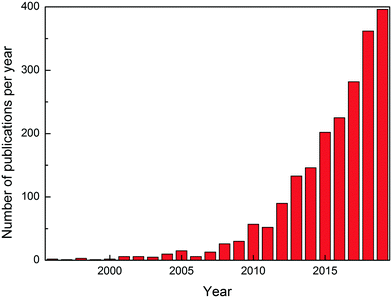Capacitive deionization and electrosorption: from desalination to ion management
Peng
Liang
 a,
Zhiyong Jason
Ren
a,
Zhiyong Jason
Ren
 b and
Xia
Huang
b and
Xia
Huang
 *a
*a
aState Key Joint Laboratory of Environment Simulation and Pollution Control, School of Environment, Tsinghua University, Beijing 100084, PR China. E-mail: xhuang@tsinghua.edu.cn
bDepartment of Civil and Environmental Engineering and Andlinger Center for Energy and the Environment, Princeton University, Princeton, NJ 08544, USA
 | ||
| Fig. 1 The numbers of annual publications on the topic of “capacitive deionization”. Data collected from Web of Science in December 2019. | ||
The development in CDI&E has been driven by the urgent need for desalination and ion management, especially for impaired water sources that have lower salinities than seawater. Compared to traditional membrane-based pressure-driven desalination technologies such as reverse osmosis, CDI&E holds a unique advantage in such conditions, as it moves relatively small concentrations of ions out of water rather than dealing with large amounts of water.
CDI&E development has largely benefited from the transformation of traditional carbon-based capacitive materials to faradaic materials, such as Prussian blue analogues and metal oxides2 and supercapacitors with energy-storing capabilities. The recent focus on modification and functionalization of carbon materials even highlighted another advantage of the CDI&E process – selective removal and recovery of targeted ions. In addition, drawing from other technologies such as electrodialysis and flow batteries, CDI architectures and operation have been modified greatly from the traditional flow-by system to membrane-CDI, flow-through CDI and flow-electrode CDI, etc.3 Emerging derivative architectures such as hybrid CDI, inverted CDI and rocking chair brought even more excitement and possibilities to the field.
Along with the technical evolution of CDI, the assessment metrics have also been largely expanded, such as desalination capacity, desalination rate, energy consumption, water recovery and stability assessments.4 Among them desalination rate and energy consumption are widely employed as the dynamic and thermodynamic indexes, respectively.
Inspired by the promising future of CDI&E related knowledge and technologies, the working group on CDI&E was founded in 2014 and has since organized 4 international conferences on the topic. The attendance of the conference has grown by an order of magnitude, with the most recent conference held in May 2019 at Tsinghua University, China. More than 220 participants from 15 countries presented their newest findings and exchanged ideas. To celebrate this event and capture the momentum of the CDI&E development, we are excited to work with Environmental Science: Water Research & Technology to assemble this themed issue on capacitive deionization. Readers can enjoy the most advanced research findings and build research networks on the following topics, and we look forward to witnessing the development and deployment of CDI&E technologies.
• Electrode materials in CDI
• Flow electrodes and applications
• Specific ion removal and nutrient recovery
• Faradaic reactions and the application
• Pilot-scale applications of CDI systems
References
- J. W. Blair and G. W. Murphy, Electrochemical demineralization of water with porous electrodes of large surface area, Saline water conversion, American Chemical Society, 1960, pp. 206–223 Search PubMed.
- F. Yu, L. Wang, Y. Wang, X. Shen, Y. Cheng and J. Ma, Faradaic reactions in capacitive deionization for desalination and ion separation, J. Mater. Chem. A, 2019, 7, 15999–16027 RSC.
- M. E. Suss, S. Porada, X. Sun, P. M. Biesheuvel, J. Yoon and V. Presser, Water desalination via capacitive deionization: what is it and what can we expect from it?, Energy Environ. Sci., 2015, 8, 2296–2319 RSC.
- S. A. Hawks, A. Ramachandran, S. Porada, P. G. Campbell, M. E. Suss, P. M. Biesheuvel, J. G. Santiago and M. Stadermann, Performance metrics for the objective assessment of capacitive deionization systems, Water Res., 2019, 152, 126–137 CrossRef CAS.
| This journal is © The Royal Society of Chemistry 2020 |
